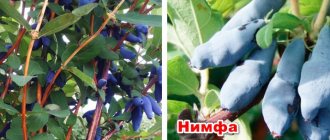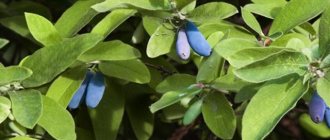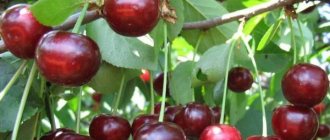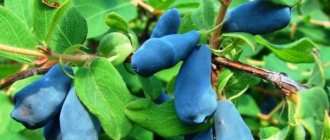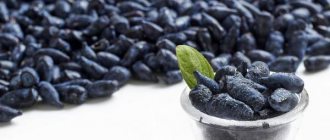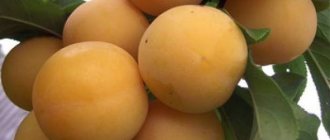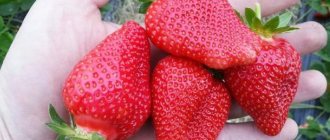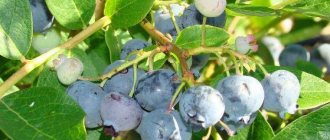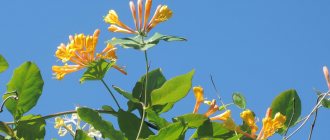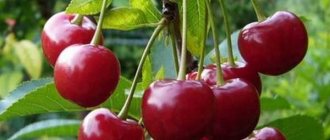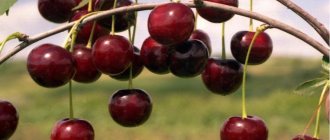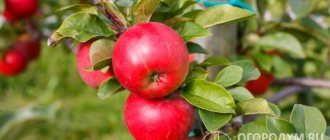Typically, regions with harsh climates have few varieties of berries that bear fruit. One of them is honeysuckle "Roxana", which can produce a harvest in Siberia, the North and the Caucasus. Despite its youth, it is widespread throughout the country. A description of the honeysuckle variety Roxana will allow you to understand whether it is worth growing it in your garden plot.
Description of the edible honeysuckle variety Roxana
The plant has high frost resistance - it can produce crops even in frosts down to -40 ° C. The honeysuckle bush has a beautiful appearance, and the taste of its berries attracts the attention of more and more people.
“Roxana” is characterized by short stature. It usually reaches 1.5 meters in height. Its round and wide crown is 60-70 cm in diameter. The shoots are thick at the base and have a pink tint at the edges. The leaves are large, slightly pubescent, dark green.
Berries contain useful substances and vitamins
Edible varieties of berries are characterized by the following features:
- Weight no more than 1.3 grams.
- The diameter of the fruit is 1 cm, length – 3 cm.
- The shape is oblong, elongated.
- The skin is dark blue with a light layer of waxy coating.
The berries have a sweet and sour taste and are a little reminiscent of strawberries. The pulp is dense and fibrous.
Attention! Eating just 50 grams of Roxana honeysuckle berries per day will help relieve stress and depression.
The plant harvest ripens late - it begins to be collected at the end of July, and in the southern regions not much earlier. Once planted, a honeysuckle bush can bear fruit for 3 years. During the season you can collect no more than 3.5 kg of berries from it.
Planting and caring for honeysuckle Roxana
In order for the plant to actively develop and produce a harvest, it needs to be provided with proper care. It starts with planting and ends with pest and disease control.
Landing dates
For good rooting of the honeysuckle bush, it is very important to choose the right planting time. It is recommended to perform the procedure in April or September, but experienced gardeners prefer spring. They do this so that the plant gets comfortable in the soil before frost sets in.
Selection and preparation of a landing site
For good growth of honeysuckle "Roxana" you need to choose the right planting site. It should provide the plant with sunlight and limit exposure to strong drafts. It is necessary to select a site in such a way that the bush is located at a distance of at least 3 meters from fruit trees and fences. The south side of the garden is better suited for this, since a large amount of sunlight will allow the fruits to gain sugar and ripen faster, which will affect their taste.
Honeysuckle needs a sufficient amount of moisture, but it should not stagnate. Therefore, where shrubs will be planted, the groundwater level should be about 3 meters. Light soil is required, the best option is chernozem or loam.
Before planting honeysuckle "Roxana", you need to prepare the ground. To do this, humus is added to it and mixed well. A hole is dug measuring 50x70 cm.
Important! If you plan to plant a lot of plants, then the plot is divided so that the distance between rows is 2 meters, and the distance between bushes in a row is 3 meters.
Landing rules
Planting honeysuckle "Roxana" is an important stage in growing the berry. It is performed in the following sequence:
- A drainage layer of river pebbles or broken bricks is poured onto the bottom of the finished hole. It will provide air to the root system.
- Add a substrate consisting of compost, manure, humus and wood ash.
- Garden soil is poured on top.
- Water the hole abundantly and leave it for 7 days.
- After this, carefully straightening the roots, plant honeysuckle.
- Sprinkle a little soil on top, water and mulch.
Mulching is one of the most reliable ways to maintain plant health.
Watering and fertilizing
The quality of care for honeysuckle “Roxana” largely depends on the correct implementation of watering and fertilizing. The shrub needs water as the soil dries out. This happens depending on weather conditions once every 5-10 days. A young plant needs three buckets of water, an adult at least five.
Honeysuckle “Roxana” should be fed no earlier than the second year after planting. Do this 3 times throughout the year:
- In April, 3-4 kg of humus is added under the root system.
- In the summer, before harvesting, the bush is watered with 3 liters of potassium solution.
- At the beginning of autumn, honeysuckle is fed with a solution of superphosphate.
Important! Once every 2-3 years it is necessary to mulch with peat or humus.
Trimming
Pruning is an important part of proper care of Roxana honeysuckle. It is recommended to perform this procedure for the first time when the plant is 2-3 years old. After this, it is not necessary to prune the bush, unless it is too thick. In this case, you need to remove several branches that grow from the ground. Additionally, dried or diseased areas of honeysuckle should be cut off. If the plant is too bushy, you can remove the internal branches to allow access to sunlight.
Young shoots of “Roxana” should not be pruned, since most of the berries grow on them. In the spring, you can remove branches damaged by frost, and after the fruiting period, make a decorative formation of the bush.
When performing the procedure of pruning honeysuckle, the main thing is not to overdo it, since “Roxana” grows for a very long time
Wintering
Since honeysuckle “Roxana” is a frost-resistant plant, it does not need any special preparation for wintering. The exception is when the temperature in the planting region drops below -40 °C, then mulching is performed during this period.
Advice! Some gardeners, fearing for their plant, cover it with plastic wrap. But then you need to ensure the bush is ventilated for several hours every day.
Agricultural technology
When growing honeysuckle of the Roxana variety, it is necessary to choose the right planting material and place for planting . Seedlings are purchased from trusted sellers or specialized nurseries. If you decide to make a purchase on a regular market, be prepared for the risk of buying low-quality planting material (affected by diseases or the wrong variety).
Important! If all agricultural technology conditions are met, honeysuckle fruiting will continue for at least 15 years.
When choosing a seedling, consider some characteristics:
- absence of diseases and pests. If you notice unusual plaque, small holes or cracks on the bushes, then it is better to refuse such a purchase. Such bushes will not produce a harvest;
- optimal height 50 cm;
- developed roots, the length of which is 30–35 cm.
After purchasing the planting material, they begin to prepare it. To disinfect, spray the seedling from a spray bottle with a solution of colloidal sulfur (30 g per 10 liters of water). Wash off the solution under running water after 3–5 hours. To speed up the development and rooting of the plant, it is necessary to soak the roots in the growth stimulator Kornevin (40 g per 5 liters of water). The shrub must be kept in this solution for at least 6 hours.
Selecting a location
Honeysuckle variety Roxana needs well-lit areas that are protected from strong gusts of wind. Therefore, it is necessary to plant shrubs at a distance of 3 m from fences or fruit trees on the south side of the garden.
The more sunlight the bushes get, the faster the berries will ripen. Also, natural lighting provokes an improvement in the taste of the berry, increasing the amount of sugar in the composition.
Honeysuckle bushes love moisture, but the water in the soil should not stagnate. Therefore, the optimal depth of groundwater is 2.5–3 m. The soil chosen is light. Loam or black soil is best suited.
Did you know? There are more than 250 different varieties of honeysuckle in the world. 14 of them are found in the wild nature of Russia.
A month before planting, they begin to prepare the site. Add 10 kg of humus per 1 m² and dig it thoroughly. After this, the area is marked. The distance between bushes should be 3 m, and between rows 2 m. This condition must be met, since plants can grow and shade each other. A hole is dug measuring 50x70 cm.
Reproduction
Honeysuckle is propagated in two ways - by seeds, cuttings and cuttings. Ordinary gardeners use the second and third methods. Only experienced breeders can grow “Roxana” with seeds. This method is performed in the following sequence:
- Rub the ripe berries on a paper towel.
- The paper is rolled up and put away. At room temperature, the seeds retain the ability to grow for several years.
- It is better to plant in June. The seeds are placed in moist soil and buried 1 mm into it. After this, they are covered with film to create greenhouse conditions.
- After 3 weeks, the first seedlings should appear. At the end of autumn they are transferred to the garden.
- When the sprouts have leaves, they are transplanted to the garden bed.
- Seedlings need to be watered regularly, loosen the soil and remove weeds.
- The first harvest from the Roxana bush is harvested after 3-4 years.
An easier way is propagation by cuttings. They are harvested before the first buds appear. It is better to choose young, strong branches with a diameter of at least 8 mm and a length of 15-18 cm.
When the planting material has been selected, propagation begins:
- The cuttings are planted in the soil to a depth of about 10 cm so that at least two buds remain on the surface.
- To ensure that the root system develops faster, the seedling is covered with film.
- You need to water the cuttings moderately, several times a day.
- Complete rooting occurs within a month.
Cuttings should be harvested in early spring before the buds open.
The most common method of propagating honeysuckle "Roxana" is by layering. This is very easy to do:
- At the beginning of summer, the soil next to the bush is loosened and slightly raised.
- They take several powerful young stems growing at the base of the bush, press them to the ground and fix them in this position.
- The shoots are sprinkled with a layer of soil about 5 cm thick.
- Until next spring, the cuttings are regularly watered.
- Then they are separated from the mother bush and transplanted to a permanent place.
- It takes several years for Roxana's cuttings to become a full-fledged plant.
Harvest and storage
The harvest is harvested in mid-July, in the south - at the end of June. This is done in several stages, as the berries ripen, since the fruits are prone to shedding.
In a dark, dry and cool room, honeysuckle is stored for 3-4 months, in the freezer - 7 months.
This is interesting:
Features of planting and caring for honeysuckle in the Urals
Kamchatka honeysuckle - description and best varieties
Decorative climbing honeysuckle - cultivation, propagation and care
Diseases and pests
The honeysuckle variety "Roxana" has a well-developed immune system, so it is not afraid of most diseases. In rare cases, it can be affected by powdery mildew, spotting, and tuberculosis. These are fungal diseases and they are characterized by the same symptoms:
- the branches begin to dry out and become brown or black;
- leaves turn yellow and fall off.
Shrubs can be cured by periodic treatment with fungicides.
Of the pests, the most dangerous for “Roxana” are: rosea leaf roller, honeysuckle miners, mites and aphids. You need to fight them by spraying the bush with insecticides.
If the leaf roller is not stopped in time, it can cause serious damage to the crop.
Harvesting and transportation, keeping quality of berries
It is better to harvest the crop immediately, as it ripens. If harvesting is delayed for 5–7 days, the berries may fall off. The shelf life of products is 3-4 months. The fruits should be placed in dry and cool rooms, where there is a minimum amount of sunlight. Shelf life can be extended to 7 months or more if you freeze them in the freezer.
The shelf life of berries is determined by storage conditions. If you regularly mix the fruits in storage containers, the time will increase by 3-5 weeks. Products need air. If the lower tiers do not receive enough oxygen, they begin to rot. As a result, all products spoil.
To grow healthy honeysuckle, which will be characterized by tasty fruits, you must adhere to all the rules of agricultural technology. By following all the recommendations, you will annually enjoy products that will not only saturate your body with useful elements, but will also complement all your winter preparations.
Source
Roxana is a variety of edible honeysuckle suitable for growing in northern regions. In addition to frost resistance, it is characterized by large berries, a pleasant taste and good immunity to diseases and pests. In the article we will give a description of the honeysuckle variety Roxana, talk in detail about the requirements for planting and care it imposes, its advantages and disadvantages.
